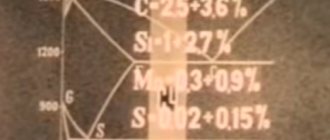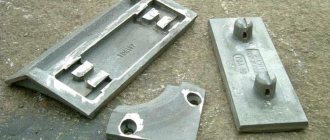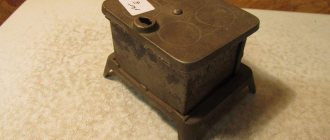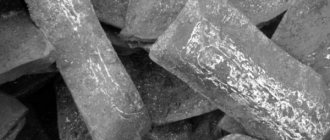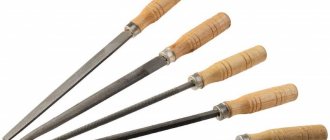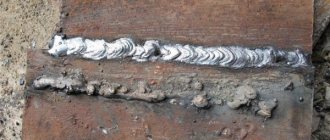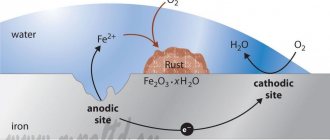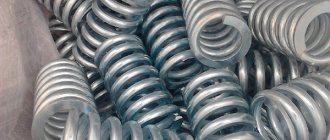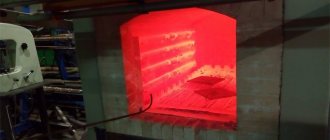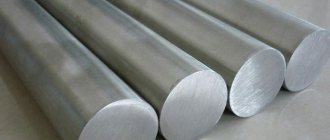Types of cast iron
Cast iron is an alloy of iron and carbon, where the content of the latter is more than 2.14%. The composition of such an alloy may also include other elements. Their content determines many parameters and properties of the material.
The iron-carbon alloy contains cementite, graphite and graphite with cementite. Cementite is a compound of carbon and iron with the composition Fe3C. Graphite is one of the allotropic modifications of carbon with a layered structure.
Depending on the content of these compounds, the color of the product changes. When cementite predominates, the material acquires a light sheen. This is where the name “white” came from.
Graphite has a dark color, which it imparts to castings. It is the structure of graphite inclusions that determines the plastic properties of the material.
Types of cast iron according to GOST.
Based on this, the alloy is divided into:
- grey;
- malleable;
- high strength;
- special purpose.
The first type of materials includes an alloy of iron and carbon in the graphite modification of flake, lamellar or globular shape. It has high casting properties. Thanks to them, it is often used to produce parts of complex shapes.
At the same time, the fragility of the alloy limits its use in products subject to tension or bending. An alloy with globular graphite is characterized by high strength properties. It is classified as one of the subspecies of gray cast iron.
The formation of graphite of the specified form is achieved thanks to the addition of magnesium and cerium. Other forms are obtained due to different cooling rates.
The shape of inclusions can be different: in the form of flakes, balls or plates. The method of producing malleable cast iron is based on obtaining the first type of structure.
Malleable cast iron contains carbon in the concentration range from 2.4–2.8%. In addition, the alloy may contain: silicon, manganese, sulfur and phosphorus. These elements influence the final properties of products.
Features of the production of malleable cast iron
Shape of graphite inclusions and metal base.
To obtain malleable cast iron, it is necessary to follow a technology based on thermal annealing of workpieces at a certain temperature. As a result of this process, cementite and austenite decompose. Thus, carbon is obtained that crystallizes in flocculent graphite.
Austenite is iron with a face-centered lattice. This modification is high temperature. In iron-carbon steels it can form at temperatures above 727 degrees, and in pure iron at 910 degrees.
The final process of graphite formation occurs at lower temperatures - in the range of 720-760 degrees. It is carbon in this modification that determines such characteristics as the ductility and strength of malleable cast iron.
The method involves heat treatment of malleable cast iron in two stages. First, the material is exposed to temperatures up to 1000 degrees. Holding castings under these conditions leads to the decomposition of ledeburite into graphite and austenite.
After annealing at high temperature, the product is cooled to 720-760 degrees. As a result, pearlite is formed, which further decomposes into ferrite and graphite.
Melting of material for the production of cast iron is carried out in cupola furnaces, flame and electric furnaces. Sometimes this process is carried out in combination furnaces. The original castings may contain varying amounts of carbon.
When producing a ferritic alloy, it is necessary to use workpieces with a lower carbon concentration. Such products have a high melting point and therefore require an increased superheating temperature.
Typically, two furnaces are used for smelting in this situation. Melting occurs in the cupola furnace, and overheating occurs in the electric arc furnace. The described smelting technology is called the duplex process.
For the production of pearlitic alloy, workpieces with a high “C” content are used. A cupola furnace is sufficient to melt such material.
A feature of the production of molds for castings is the increased shrinkage of the white alloy. Because of this process, it becomes necessary to install side profits at each local thickening of the casting. This avoids the formation of shells.
In order to increase the cooling rate of thicker parts of the casting, metal coolers are used.
The influence of carbon and silicon on the structure of cast iron and the dependence of the structure on the thickness of cast iron.
The name of this material is due only to its higher plastic properties. In fact, it cannot be forged. This type of alloy is used in the same way as its other types.
The advantage of malleable cast iron, compared to white cast iron, is its high corrosion resistance. In terms of this property, the material ranks higher than carbon steels. In mechanical properties it is inferior to steel, but superior to white cast iron.
Properties
The mechanical properties of cast iron directly depend on how much carbon it contains and in what form this component is presented. Characteristics may vary due to the addition of alloying impurities. These include silicon, manganese, sulfur, phosphorus and chromium. This material is made from white cast iron after annealing at high temperatures. Properties of malleable material:
- High strength and ductility.
- Good viscosity.
- The material has high wear resistance.
Ductile iron is the best type of base alloy. Massive structures are made from it, the individual parts of which are connected using welding equipment.
Types of malleable cast iron
Depending on the production process, malleable cast iron is either ferritic or pearlitic. In the first case, production is carried out in a neutral environment. This material has a ferritic structure with residual annealing carbon.
The composition of the alloy before heat treatment includes 2.2-2.99 percent carbon, as well as additives of other elements, the content of which does not exceed one percent. A decrease in con is accompanied by an increase in the strength characteristics of the material. However, its casting properties are reduced.
This material is widely used in the manufacture of parts for machines and agricultural equipment, where resistance to constant loads and stresses is required.
Heat treatment of products in an oxidizing environment leads to the formation of white-core or pearlitic cast iron. This alloy differs in other carbon concentrations before annealing - 2.8-3.3 percent. After thermal exposure, the amount of carbon drops to 0.6-2.2%.
This alloy has lower plastic properties. In this regard, it is used in tasks that do not require resistance to severe plastic and chemical loads.
Properties of malleable cast irons
Composition of malleable cast iron.
Malleable cast iron has mechanical properties that depend on the silicon-carbon content in the graphite allotropic modification. For white-core material, chromium and manganese also have an effect.
The difference in the structure of products also determines the difference in properties. Thus, the black-core alloy is characterized by greater ductility, but lower hardness than the pearlite type.
The high strength characteristics of these alloys are provided by flake-shaped graphite. Despite their name, these products cannot be forged. They are made by casting parts into specified shapes.
The main advantage of a malleable alloy is the uniformity of properties across the cross-section of the material, as well as the absence of stress.
In terms of other characteristics they differ:
- good fluidity during casting;
- absorption of vibrations;
- high wear resistance;
- good corrosion resistance to moisture and many aggressive chemical compounds;
- high resistance to shock loads.
Main characteristics of the metal
The main characteristics of the metal directly depend on the percentage of carbon in its composition. The structure of malleable cast iron is a crystal lattice containing carbon particles in the form of graphite. Additionally, the composition contains small amounts of silicon, manganese and chromium.
The structure of a malleable material affects the parts and workpieces made from it. For example, the ferritic variety of material has a lower strength index than pearlite. When using flake-shaped graphite particles, the material becomes more durable and ductile. Parts made from ductile iron can change size and shape when exposed to room temperature and humidity levels for long periods of time.
However, the name of the material cannot indicate the processing methods. This type of cast iron, according to the standards specified in GOSTs, is not produced using forging equipment. For this, casting technology is used. Thanks to this, there are no internal or surface stresses in the finished metal. Characteristics:
- High fluidity and strength.
- Resistance to corrosive processes.
- The metal can withstand prolonged exposure to acids and alkalis.
However, the performance of this material quickly deteriorates when exposed to low temperatures. It becomes brittle and is destroyed by impacts.
Areas of use of the material
Mechanical properties and chemical composition of cast iron.
The use of malleable cast iron was found in mechanical engineering, automotive industry, in the production of railway cars, and in the manufacture of agricultural equipment.
The best properties for the noted applications are the pearlite type. However, despite the higher characteristics, black-heart alloy is more often used. This is due to lower production costs.
Only for the manufacture of parts subject to high loads, white-core material is used. Such products include springs, engine parts, etc.
Application of malleable cast iron in agriculture, automobile and shipbuilding
Mechanical properties of malleable cast iron according to GOST 1215-79.
CP is used in mechanical engineering, the main consumers being the areas of tractor construction and agricultural machinery. Ferritic cast iron has high viscosity and strength; it is used for the production of components that are not subject to abrasion, for example, flanges, levers, forks. Various parts are made from pearlitic cast iron: diesel engine pistons, rocker arms, clutch assemblies, crankshafts, camshafts with cams, which, interacting with the pushers, operate the unit in a certain cycle, chain links, pawls, ridges, knife heads, brake drums and etc.
These products operate under the influence of static and dynamic loads and abrasion. The advantages of pearlitic cast iron are strength, wear resistance, high fatigue strength, resistance to high temperatures, and elimination of vibration.
CC is used in the automotive industry in the manufacture of thin-walled domestic castings operating under the influence of dynamic alternating loads.
https://www.youtube.com/watch?v=oVccy-PsKTs
Drives, gearboxes, wheel hubs, gears, gear housings, differentials, steering systems, engine and spring brackets, brake pads, rollers, linings, plugs, balancers, wings, cardan shafts, manifolds, etc. are made from the alloy. KCh is widely used in shipbuilding in the production of equipment for ships. It is used to make portholes, mast brackets, rowlocks, bridges, and models of steam and water fittings.
In the carriage industry they are used in the manufacture of spare parts for air brakes, bearings, brackets, traction couplings, shock-traction devices, brackets; These parts work under loads of impacts, bending, and wear.
Bottom line
Malleable cast irons have found wide application in various areas of human activity due to their high strength properties and good corrosion resistance.
They are used for the manufacture of various parts that must withstand significant constant and periodic loads.
Depending on the tasks, either ferritic or pearlitic type of material can be used. Each of them has its own advantages and disadvantages, described in this article.
https://youtu.be/F6ApHPhpnok
